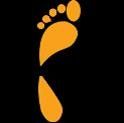
People run for many different reasons. For some, it gives them a positive energy boost, and it’s an ideal way to keep their weight in check. For others, it’s the buzz of competition, or quite simply, because they enjoy it. One of the first steps to healthy running is wearing supportive running shoes. Neglecting to wear proper footwear can lead to a variety of foot problems that can cause injury and impede performance.
To find the best running shoe, you must first determine your foot type. Are you a pronator, a supinator, or do you have neutral feet? Pronators have relatively flat feet and rolled in ankles (as observed when standing), leading to overpronation (gait in which the ankle rolls inward excessively). Supinators have high arches, leading to underpronation and rolled out ankles (gait in which too much weight is placed on the outside of the feet). And finally, if you have neutral feet, you have a foot that is in-between a flat-foot and high arch. These 3 different foot types directly affect knee alignment. Supinated and pronated feet place a “twist” in the knee joint can causing mal-tracking of the knee cap (patella).
Dr. Robert Steinberg will perform a gait analysis and provide suggestions about the best running shoe for your foot type. Through his analysis of your gait, he will also determine if a pair of prescription functional foot orthotics will improve the efficiency of your running and walking, better protect you from overuse injuries, and address pain you might be having in your foot, ankle, shin, or knee.

People run for many different reasons. For some, it gives them a positive energy boost, and it’s an ideal way to keep their weight in check. For others, it’s the buzz of competition, or quite simply, because they enjoy it. One of the first steps to healthy running is wearing supportive running shoes. Neglecting to wear proper footwear can lead to a variety of foot problems that can cause injury and impede performance.
To find the best running shoe, you must first determine your foot type. Are you a pronator, a supinator, or do you have neutral feet? Pronators have relatively flat feet and rolled in ankles (as observed when standing), leading to overpronation (gait in which the ankle rolls inward excessively). Supinators have high arches, leading to underpronation and rolled out ankles (gait in which too much weight is placed on the outside of the feet). And finally, if you have neutral feet, you have a foot that is in-between a flat-foot and high arch. These 3 different foot types directly affect knee alignment. Supinated and pronated feet place a “twist” in the knee joint can causing mal-tracking of the knee cap (patella).
Dr. Robert Steinberg will perform a gait analysis and provide suggestions about the best running shoe for your foot type. Through his analysis of your gait, he will also determine if a pair of prescription functional foot orthotics will improve the efficiency of your running and walking, better protect you from overuse injuries, and address pain you might be having in your foot, ankle, shin, or knee.
